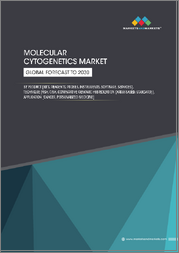
|
시장보고서
상품코드
1675300
세계의 생식 유전학 시장 : 제품 유형별, 시술 유형별, 기술별, 용도별, 지역별(2025-2033년)Reproductive Genetics Market Report by Product Type, Procedure Type, Technology, Application, and Region 2025-2033 |
||||||
생식 유전학 시장 세계 시장 규모는 2024년 72억 달러에 달했습니다. 향후 IMARC Group은 2033년까지 시장 규모가 598억 달러에 달하고, 2025년부터 2033년까지 25.13%의 연평균 성장률(CAGR)을 나타낼 것으로 전망하고 있습니다. 유전성 질환에 대한 대중의 인식과 이해 증가, 예방적 건강관리의 도입 증가, 보조생식술(ART)의 보급으로 인한 출산율 증가가 시장을 이끄는 주요 요인 중 일부입니다.
생식 유전학은 유전 정보와 그것이 생식 건강과 결과에 미치는 영향에 대한 연구에 초점을 맞춘 유전학의 한 분야를 말합니다. 불임, 임신, 부모로부터 자녀로의 유전적 질병 전달과 관련된 유전적 요인 분석과 이해가 포함됩니다. 생식 유전학은 생식 과정에서 유전적 상태의 확인과 관리를 목적으로 하는 다양한 기술과 기법을 포괄합니다. 개인 또는 부부를 대상으로 특정 유전자 돌연변이 또는 보균자 유무에 대한 스크리닝을 실시하여 유전 질환이 자녀에게 유전될 위험을 평가합니다. 체외수정(IVF)과 같은 보조생식술에서 PGD는 자궁에 착상하기 전에 배아의 유전적 이상을 분석하여 특정 유전질환이 없는 배아를 선별하는 데 도움을 줍니다. 생식 유전학은 개인이나 부부의 보균 상태와 특정 유전자 변이의 존재를 확인하여 유전 질환이 자손에게 유전될 위험을 평가하는 데 도움이 됩니다.
생식 유전학 시장 동향 :
세계 시장의 주요 원동력은 유전자 질환에 대한 대중의 인식과 이해 증가입니다. 또한, 예방적 건강관리의 확산과 함께 미래 자녀의 유전적 질환 위험을 파악하기 위해 유전자 검사를 받는 부모 후보자들이 증가하고 있는 것도 시장을 견인하고 있습니다. 출산율 증가에 따라 체외수정(IVF), 대리모 등 보조생식술(ART)의 이용이 증가하고 있어 시장 전망은 밝습니다. 이에 따라 차세대염기서열분석(NGS), 고해상도 마이크로어레이 등 첨단 유전자 검사 기술의 지속적인 기술 개발이 시장을 자극하고 있습니다. 또한, 여성의 염색체 이상에 대한 민감도가 높아지면서 산모의 연령이 높아지는 것도 시장에 활력을 불어넣고 있습니다. 이와 더불어 여러 국가의 정부가 유전자 연구 및 검사를 지원하려는 움직임이 강화되고 있어 시장 성장을 가속하고 있습니다. 또한, 유전체 시퀀싱 방법의 가격이 상승하고 대중이 더 쉽게 접근할 수 있게 된 것도 시장을 주도하고 있습니다. 기타 시장 성장에 기여하는 다른 요인으로는 특히 신흥국의 소득 수준 증가, 소비자에게 직접 유전자 검사를 제공하는 조직의 급증, 개인 맞춤형 의료의 지속적인 기술 혁신, 광범위한 조사 개발(R&D) 활동 등이 있습니다.
본 보고서에서 다룬 주요 질문
- 세계 생식 유전학 시장은 지금까지 어떻게 성장해 왔는가?
- 세계 생식 유전학 시장 성장 촉진요인, 저해요인, 기회요인은 무엇인가?
- 각 촉진요인, 억제요인, 기회가 세계 생식 유전학 시장에 미치는 영향은?
- 주요 지역 시장은?
- 가장 매력적인 생식 유전학 시장은 어느 국가인가?
- 제품 유형별 시장 분석은?
- 생식 유전학 시장에서 가장 매력적인 제품 유형은?
- 시술 유형별 시장 분석은?
- 생식 유전학 시장에서 가장 매력적인 시술 유형은?
- 기술별 시장 분석은?
- 생식 유전학 시장에서 가장 매력적인 기술은 무엇인가?
- 용도별 시장 분석은?
- 생식 유전학 시장에서 가장 매력적인 용도는?
- 세계 생식 유전학 시장 경쟁 구도는?
- 세계 생식 유전학 시장의 주요 기업은?
목차
제1장 서문
제2장 조사 범위와 조사 방법
- 조사 목적
- 이해관계자
- 데이터 소스
- 1차 정보
- 2차 정보
- 시장 추정
- 보텀업 접근
- 톱다운 접근
- 조사 방법
제3장 주요 요약
제4장 서론
- 개요
- 주요 업계 동향
제5장 세계의 생식 유전학 시장
- 시장 개요
- 시장 실적
- COVID-19의 영향
- 시장 예측
제6장 시장 분석 : 제품 유형별
- 키트
- 임상 검사(LDT)
- 시약 및 소모품
제7장 시장 분석 : 시술 유형별
- 캐리어 스크리닝
- 산전 스크리닝
- 착상전 유전자 검사
- 불임 유전자 검사
제8장 시장 분석 : 기술별
- 차세대 시퀀싱
- 중합효소 연쇄반응(PCR)
- In Situ Hybridization (ISH/FISH)
- 마이크로어레이
제9장 시장 분석 : 용도별
- 이수성
- 염색체 구조 이상
- 단일 유전자 질환
- 기타
제10장 시장 분석 : 지역별
- 북미
- 미국
- 캐나다
- 아시아태평양
- 중국
- 일본
- 인도
- 한국
- 호주
- 인도네시아
- 기타
- 유럽
- 독일
- 프랑스
- 영국
- 이탈리아
- 스페인
- 러시아
- 기타
- 라틴아메리카
- 브라질
- 멕시코
- 기타
- 중동 및 아프리카
- 시장 분석 : 국가별
제11장 성장 촉진요인 및 억제요인, 기회
- 개요
- 성장 촉진요인
- 성장 억제요인
- 기회
제12장 밸류체인 분석
제13장 Porter의 Five Forces 분석
- 개요
- 바이어의 교섭력
- 공급 기업의 교섭력
- 경쟁 정도
- 신규 진출업체의 위협
- 대체품의 위협
제14장 가격 분석
제15장 경쟁 구도
- 시장 구조
- 주요 기업
- 주요 기업 개요
- Bangkok Genomics Innovation Public Company Limited
- Centogene N.V.
- Fulgent Genetics Inc.
- Igenomix(Vitrolife Group)
- Invitae Corporation
- Laboratory Corporation of America Holdings
- PerkinElmer Inc.
- Thermo Fisher Scientific Inc.
The global reproductive genetics market size reached USD 7.2 Billion in 2024. Looking forward, IMARC Group expects the market to reach USD 59.8 Billion by 2033, exhibiting a growth rate (CAGR) of 25.13% during 2025-2033. The growing awareness and understanding of genetic disorders among the masses, the rising adoption of preventive healthcare, and the increasing fertility rates leading to a higher uptake of assisted reproductive technologies (ART) represent some of the key factors driving the market.
Reproductive genetics refers to the branch of genetics that focuses on the study of genetic information and its impact on reproductive health and outcomes. It involves the analysis and understanding of genetic factors related to fertility, pregnancy, and the transmission of genetic disorders from parents to their offspring. Reproductive genetics encompasses various techniques and technologies aimed at identifying and managing genetic conditions during the reproductive process. Screening individuals or couples for specific genetic mutations or carrier status to assess the risk of passing on genetic disorders to their children. In assisted reproductive technologies such as in vitro fertilization (IVF), PGD involves the analysis of embryos for genetic abnormalities before their implantation in the uterus, helping to select embryos without specific genetic disorders. Reproductive genetics helps assess the risk of transmitting genetic disorders to offspring by identifying carrier status or the presence of specific genetic mutations in individuals or couples.
Reproductive Genetics Market Trends:
The global market is primarily driven by the growing awareness and understanding of genetic disorders among the masses. Also, the rising adoption of preventive healthcare leading to a higher number of prospective parents undergoing genetic testing to understand the risks of genetic disorders in their future children is fueling the market. With the increasing fertility rates, there is a higher uptake of assisted reproductive technologies (ART) such as In-Vitro Fertilization (IVF) and surrogacy, which is creating a positive market outlook. In line with this, continual technological developments in advanced genetic testing techniques such as Next-Generation Sequencing (NGS) and high-resolution microarrays are stimulating the market. Moreover, the increasing maternal age resulting in a higher susceptibility of chromosomal abnormalities in women is providing an impetus to the market. In addition to this, governments of several countries are increasingly supporting genetic research and testing, thereby catalyzing the growth of the market. The market is further driven by the rising affordability of genomic sequencing procedures, resulting in higher accessibility among the masses. Some of the other factors contributing to the market include inflating income levels, particularly in developing countries, the proliferation of organizations offering direct-to-consumer genetic tests, continual innovations in personalized medicine, and extensive research and development (R&D) activities.
Key Market Segmentation:
Product Type Insights:
- Kits
- Laboratory Developed Tests (LDT)
- Reagents and Consumables
Procedure Type Insights:
- Carrier Screening
- Pre-Natal Screening
- Pre-Implantation Genetic Testing
- Infertility Genetic Testing
Technology Insights:
- Next-Generation Sequencing
- Polymerase Chain Reaction
- In Situ Hybridization (ISH/FISH)
- Microarray
Application Insights:
- Aneuploidy
- Structural Chromosomal Abnormality
- Single Gene Disorder
- Others
Regional Insights:
- North America
- United States
- Canada
- Asia Pacific
- China
- Japan
- India
- South Korea
- Australia
- Indonesia
- Others
- Europe
- Germany
- France
- United Kingdom
- Italy
- Spain
- Russia
- Others
- Latin America
- Brazil
- Mexico
- Others
- Middle East and Africa
- The report has also provided a comprehensive analysis of all the major regional markets, which include North America (the United States and Canada); Asia Pacific (China, Japan, India, South Korea, Australia, Indonesia, and others); Europe (Germany, France, the United Kingdom, Italy, Spain, Russia and others); Latin America (Brazil, Mexico, and others); and the Middle East and Africa. According to the report, North America was the largest market for reproductive genetics. Some of the factors driving the North America reproductive genetics market included its continual technological advancements in the field of genetics, the rising adoption of preventive healthcare high healthcare expenditure, etc.
Competitive Landscape:
- The report has also provided a comprehensive analysis of the competitive landscape in the global reproductive genetics market. Detailed profiles of all major companies have been provided. Some of the companies covered include Bangkok Genomics Innovation Public Company Limited, Centogene N.V., Fulgent Genetics Inc., Igenomix (Vitrolife Group), Invitae Corporation, Laboratory Corporation of America Holdings, PerkinElmer Inc., Thermo Fisher Scientific Inc., etc. Kindly note that this only represents a partial list of companies, and the complete list has been provided in the report.
Key Questions Answered in This Report:
- How has the global reproductive genetics market performed so far, and how will it perform in the coming years?
- What are the drivers, restraints, and opportunities in the global reproductive genetics market?
- What is the impact of each driver, restraint, and opportunity on the global reproductive genetics market?
- What are the key regional markets?
- Which countries represent the most attractive reproductive genetics market?
- What is the breakup of the market based on the product type?
- Which is the most attractive product type in the reproductive genetics market?
- What is the breakup of the market based on the procedure type?
- Which is the most attractive procedure type in the reproductive genetics market?
- What is the breakup of the market based on the technology?
- Which is the most attractive technology in the reproductive genetics market?
- What is the breakup of the market based on the application?
- Which is the most attractive application in the reproductive genetics market?
- What is the competitive structure of the global reproductive genetics market?
- Who are the key players/companies in the global reproductive genetics market?
Table of Contents
1 Preface
2 Scope and Methodology
- 2.1 Objectives of the Study
- 2.2 Stakeholders
- 2.3 Data Sources
- 2.3.1 Primary Sources
- 2.3.2 Secondary Sources
- 2.4 Market Estimation
- 2.4.1 Bottom-Up Approach
- 2.4.2 Top-Down Approach
- 2.5 Forecasting Methodology
3 Executive Summary
4 Introduction
- 4.1 Overview
- 4.2 Key Industry Trends
5 Global Reproductive Genetics Market
- 5.1 Market Overview
- 5.2 Market Performance
- 5.3 Impact of COVID-19
- 5.4 Market Forecast
6 Market Breakup by Product Type
- 6.1 Kits
- 6.1.1 Market Trends
- 6.1.2 Market Forecast
- 6.2 Laboratory Developed Tests (LDT)
- 6.2.1 Market Trends
- 6.2.2 Market Forecast
- 6.3 Reagents and Consumables
- 6.3.1 Market Trends
- 6.3.2 Market Forecast
7 Market Breakup by Procedure Type
- 7.1 Carrier Screening
- 7.1.1 Market Trends
- 7.1.2 Market Forecast
- 7.2 Pre-Natal Screening
- 7.2.1 Market Trends
- 7.2.2 Market Forecast
- 7.3 Pre-Implantation Genetic Testing
- 7.3.1 Market Trends
- 7.3.2 Market Forecast
- 7.4 Infertility Genetic Testing
- 7.4.1 Market Trends
- 7.4.2 Market Forecast
8 Market Breakup by Technology
- 8.1 Next-Generation Sequencing
- 8.1.1 Market Trends
- 8.1.2 Market Forecast
- 8.2 Polymerase Chain Reaction
- 8.2.1 Market Trends
- 8.2.2 Market Forecast
- 8.3 In Situ Hybridization (ISH/FISH)
- 8.3.1 Market Trends
- 8.3.2 Market Forecast
- 8.4 Microarray
- 8.4.1 Market Trends
- 8.4.2 Market Forecast
9 Market Breakup by Application
- 9.1 Aneuploidy
- 9.1.1 Market Trends
- 9.1.2 Market Forecast
- 9.2 Structural Chromosomal Abnormality
- 9.2.1 Market Trends
- 9.2.2 Market Forecast
- 9.3 Single Gene Disorder
- 9.3.1 Market Trends
- 9.3.2 Market Forecast
- 9.4 Others
- 9.4.1 Market Trends
- 9.4.2 Market Forecast
10 Market Breakup by Region
- 10.1 North America
- 10.1.1 United States
- 10.1.1.1 Market Trends
- 10.1.1.2 Market Forecast
- 10.1.2 Canada
- 10.1.2.1 Market Trends
- 10.1.2.2 Market Forecast
- 10.1.1 United States
- 10.2 Asia-Pacific
- 10.2.1 China
- 10.2.1.1 Market Trends
- 10.2.1.2 Market Forecast
- 10.2.2 Japan
- 10.2.2.1 Market Trends
- 10.2.2.2 Market Forecast
- 10.2.3 India
- 10.2.3.1 Market Trends
- 10.2.3.2 Market Forecast
- 10.2.4 South Korea
- 10.2.4.1 Market Trends
- 10.2.4.2 Market Forecast
- 10.2.5 Australia
- 10.2.5.1 Market Trends
- 10.2.5.2 Market Forecast
- 10.2.6 Indonesia
- 10.2.6.1 Market Trends
- 10.2.6.2 Market Forecast
- 10.2.7 Others
- 10.2.7.1 Market Trends
- 10.2.7.2 Market Forecast
- 10.2.1 China
- 10.3 Europe
- 10.3.1 Germany
- 10.3.1.1 Market Trends
- 10.3.1.2 Market Forecast
- 10.3.2 France
- 10.3.2.1 Market Trends
- 10.3.2.2 Market Forecast
- 10.3.3 United Kingdom
- 10.3.3.1 Market Trends
- 10.3.3.2 Market Forecast
- 10.3.4 Italy
- 10.3.4.1 Market Trends
- 10.3.4.2 Market Forecast
- 10.3.5 Spain
- 10.3.5.1 Market Trends
- 10.3.5.2 Market Forecast
- 10.3.6 Russia
- 10.3.6.1 Market Trends
- 10.3.6.2 Market Forecast
- 10.3.7 Others
- 10.3.7.1 Market Trends
- 10.3.7.2 Market Forecast
- 10.3.1 Germany
- 10.4 Latin America
- 10.4.1 Brazil
- 10.4.1.1 Market Trends
- 10.4.1.2 Market Forecast
- 10.4.2 Mexico
- 10.4.2.1 Market Trends
- 10.4.2.2 Market Forecast
- 10.4.3 Others
- 10.4.3.1 Market Trends
- 10.4.3.2 Market Forecast
- 10.4.1 Brazil
- 10.5 Middle East and Africa
- 10.5.1 Market Trends
- 10.5.2 Market Breakup by Country
- 10.5.3 Market Forecast
11 Drivers, Restraints, and Opportunities
- 11.1 Overview
- 11.2 Drivers
- 11.3 Restraints
- 11.4 Opportunities
12 Value Chain Analysis
13 Porters Five Forces Analysis
- 13.1 Overview
- 13.2 Bargaining Power of Buyers
- 13.3 Bargaining Power of Suppliers
- 13.4 Degree of Competition
- 13.5 Threat of New Entrants
- 13.6 Threat of Substitutes
14 Price Analysis
15 Competitive Landscape
- 15.1 Market Structure
- 15.2 Key Players
- 15.3 Profiles of Key Players
- 15.3.1 Bangkok Genomics Innovation Public Company Limited
- 15.3.1.1 Company Overview
- 15.3.1.2 Product Portfolio
- 15.3.2 Centogene N.V.
- 15.3.2.1 Company Overview
- 15.3.2.2 Product Portfolio
- 15.3.3 Fulgent Genetics Inc.
- 15.3.3.1 Company Overview
- 15.3.3.2 Product Portfolio
- 15.3.4 Igenomix (Vitrolife Group)
- 15.3.4.1 Company Overview
- 15.3.4.2 Product Portfolio
- 15.3.5 Invitae Corporation
- 15.3.5.1 Company Overview
- 15.3.5.2 Product Portfolio
- 15.3.6 Laboratory Corporation of America Holdings
- 15.3.6.1 Company Overview
- 15.3.6.2 Product Portfolio
- 15.3.7 PerkinElmer Inc.
- 15.3.7.1 Company Overview
- 15.3.7.2 Product Portfolio
- 15.3.8 Thermo Fisher Scientific Inc.
- 15.3.8.1 Company Overview
- 15.3.8.2 Product Portfolio
- 15.3.1 Bangkok Genomics Innovation Public Company Limited
Kindly note that this only represents a partial list of companies, and the complete list has been provided in the report.



















